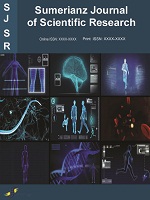Sumerianz Journal of Scientific Research

Online ISSN: 2617-6955
Print ISSN: 2617-765X
Quarterly Published (4 Issues Per Year)
Journal Website: https://www.sumerianz.com/?ic=journal-home&journal=29Archive
Volume 4 Issue 1 (2021)
Infrared Spectrum for the New Exobiological Nanomolecules Asi, Csi, Tsi and Gsi
Authors : Ricardo Gobato ; Alireza Heidari ; Lauro Figueroa Valverde ; Abhijit Mitra
DOI : doi.org/10.47752/sjsr.41.25.31
Abstract:The core of the work is based on the replacement of carbon atoms by silicon atoms, on the basis of four standard bases of DNA: A, C, G and T (adenine, cytosine, guanine, thymine). Determining with minimum computational methods via ab initio Hartree-Fock methods, infrared spectrum and their peak absorbance frequencies. The option for simple replacement of carbon by silicon is due to the peculiar characteristics between both. Atomic interactions under non-carbon conditions were studied, with only the Hydrogen, Silicon, Nitrogen and Oxygen atoms, in CNTP, for the four standard bases of DNA, A, C, G and T, thus obtaining by quantum chemistry four new compounds, named here as: ASi, CSi, GSi and TSi. Computational calculations admit the possibility of the formation of such molecules, their existence being possible via quantum chemistry. Calculations obtained in the ab initio Unrestricted and Restrict Hartree-Fock method, (UHF and RHF) in the set of basis used Effective core potential (ECP) minimal basis, UHF CEP-31G (ECP split valance) and UHF CEP-121G (ECP triple-split basis), CC-pVTZ (Correlation-consistent valence-only basis sets triple-zeta) and 6-311G**(3df, 3pd) (Gaussian functions quadruple-zeta basis sets).
Sustainable Energy: Challenges of Implementing New Technologies
Authors : Abdeen Mustafa Omer
DOI : doi.org/10.47752/sjsr.41.8.24
Abstract:Sudan is an agricultural country with fertile land, plenty of water resources, livestock, forestry resources, and agricultural residues. Energy is one of the key factors for the development of national economies in Sudan. An overview of the energy situation in Sudan is introduced with reference to the end uses and regional distribution. Energy sources are divided into two main types; conventional energy (biomass, petroleum products, and electricity); and non-conventional energy (solar, wind, hydro, etc.). Sudan possesses a relatively high abundance of sunshine, solar radiation, and moderate wind speeds, hydro, and biomass energy resources. Application of new and renewable sources of energy available in Sudan is now a major issue in the future energy strategic planning for the alternative to the fossil conventional energy to provide part of the local energy demand. Sudan is an important case study in the context of renewable energy. It has a long history of meeting its energy needs through renewables. Sudan’s renewables portfolio is broad and diverse, due in part to the country’s wide range of climates and landscapes. Like many of the African leaders in renewable energy utilisation, Sudan has a well-defined commitment to continue research, development, and implementation of new technologies. Sustainable low-carbon energy scenarios for the new century emphasise the untapped potential of renewable resources. Rural areas of Sudan can benefit from this transition. The increased availability of reliable and efficient energy services stimulates new development alternatives. It is concluded that renewable environmentally friendly energy must be encouraged, promoted, implemented, and demonstrated by full-scale plant especially for use in remote rural areas.
Caristi’s Fixed Point Theorem in G-Metric Spaces and Applications
Authors : Iluno C. ; Adetowubo A. ; Adewale O. K.
DOI : doi.org/10.47752/sjsr.41.3.7
Abstract:In this paper, we give some versions of Caristi’s fixed point theorem in a more general metric spacesetting. Our work extends a good number of results in this area of research.
Type 2 Vague Events and Their Applications
Authors : Houju Hori Jr.
DOI : doi.org/10.47752/sjsr.41.1.2.
Abstract:[1] discovered a mapping formula for Type 1 Vague events, and presented an alternative problem as an example of its application. Since it is well known that the alternative problem results in sequential Bayesian inference, the subsequent research flow is to make the mapping formula multidimensional, to derive the Markov (decision) process by introducing the concept of time, and so on. Furthermore, the stochastic differential equation from which it is derived was formulated. [2] This paper refers to Type 2 Vague events based on the secondary mapping formula. This quadratic mapping formula gives a certain rotation to a non-mapping function by transforming it with a relationship between the two mapping functions. Furthermore, here we refer to the derivation of the Type 2 Vague Markov process and the initial and stop conditions for its rotation.



